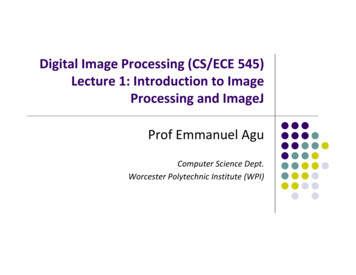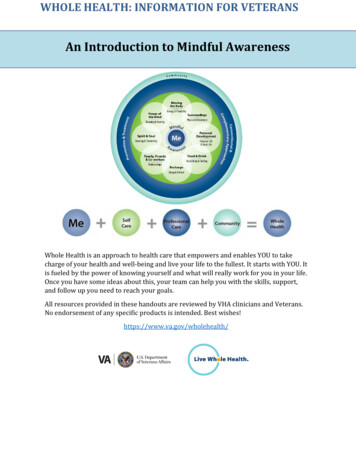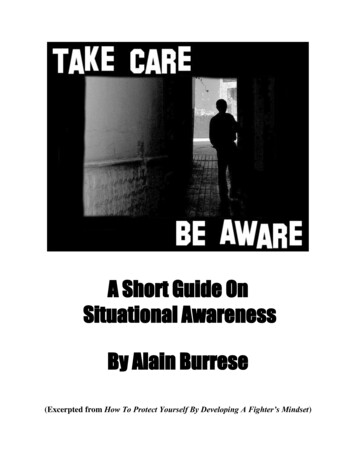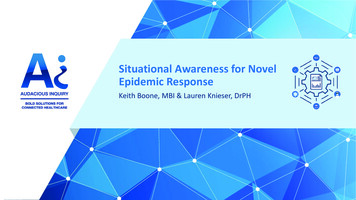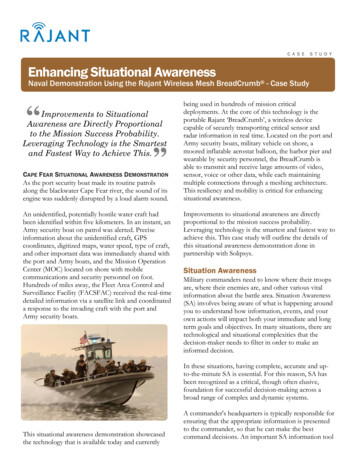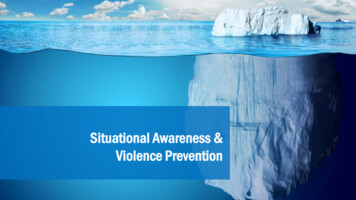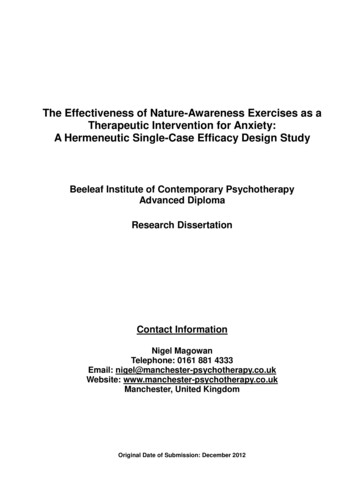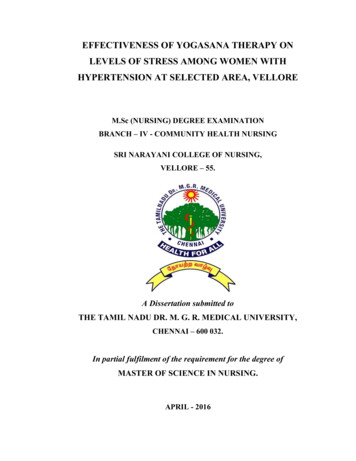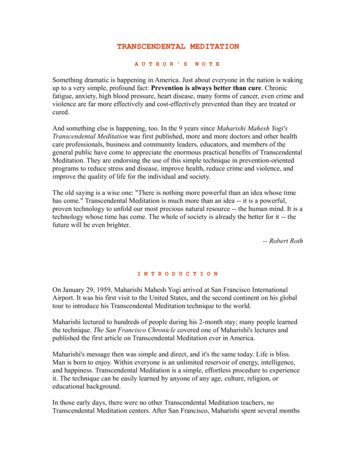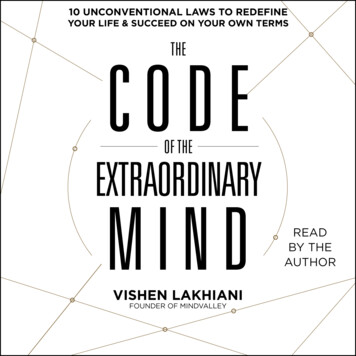
Transcription
Four Levels of Awareness
Circle of Squares
StagnationQualityof LifeStagnationSlow and Steady GrowthTime
Life as a Beautiful JoyrideQualityof LifeWoohoo!Not againYeah, baby!Here we go!Wheee! #%@Oh, crapHangon . . .Oh, noTime
A Rebel in the CulturescapeCulturescapeMisfit, Rebel,or TroublemakerEveryone Else“Dent in theUniverse”CulturescapeVisionaryEveryone Else
Ascending to Level II of the CulturescapeLevel I:Life within the culturescape.The Xs represent potential Brules.Level II:You learn to create your own versionof the world within the culturescape.Within your world (the bubble aroundyou), you can choose to eliminateand filter incoming Brules.
What You KnowYou BelieveWhat You Don’tKnow You BelieveYour awareness of your beliefs
Exponential GrowthChapter 3–10(Wow, I’m fast.)Chapter 2Chapter 16
Mapping of Set Point SystemEstablish set pointTest your pointperiodicallyNo?Turn up the heat!Set a higherset-point goalEnact set-pointcorrectionprocedureNSucceed?YYes? All good!
Four States of Human Living
Forward Gap
Reverse Gap
Twelve Areas of BalanceYour Love RelationshipYour FriendshipsYour AdventuresYour EnvironmentYour Health and FitnessYour Intellectual LifeYour SkillsYour Spiritual LifeYour CareerYour Creative LifeYour Family LifeYour Community Life}}}ExperiencesGrowthContribution
Three Most Important Questions
Follow these five steps to stay on track. Use this quick guideto double-check your goals to see if they’re in full alignment with what youreally want. Mia Koning, our chief facilitator at A-Fest, designed these fivesteps, which added further clarity to the process:1. Identify a goal.2. Answer this question exhaustively until you have no more answers:When I achieve this goal, I will be able to , , , [etc.].3. Answer this question exhaustively, until you have no more answers:When I achieve all this, I will feel , , [etc.].4. Identify the true underlying objectives of your goal, based on youranswers to questions 2 and 3.5. Compare these objectives with the original goal and ask: Is this original goal the only way/best way to achieve theseobjectives? Is this original goal enough to achieve them? Can I achieve them in a more effective way?When you do this, you will often find that what you think is an end goalis really a means goal. You will also get clarity on what the actual end goalmight be. This will free you to ensure that you’re really pursuing the rightend goal.What to do with your list. Stick it up on a wall where you can seeit and keep consciously and subconsciously working toward your goals. Shareit with others for all the reasons I mentioned. You’ll be empowering others togrow and giving yourself new opportunities to grow as well. I cannot expresshow powerful this is as an exercise for companies. It’s one of the most important exercises for cultivating great culture at Mindvalley, and thousands ofcompanies are doing the same. Why not introduce it to your workplace?The Good NewsThe good news is that you’re already on your way. Something amazinghappens when you set big, beautiful end goals. Your brain latches on towhat you’re seeing and feeling. It goes to work, hacking its way towardyour goals. Steve Jobs said it wisely:
You can’t connect the dots looking forward; you can only connectthem looking backward. So you have to trust that the dots will somehow connect in your future. You have to trust in something—yourgut, destiny, life, karma, whatever. Because believing that the dotswill connect down the road will give you the confidence to followyour heart even when it leads you off the well-worn path; and thatwill make all the difference.When you ask the Three Most Important Questions right, you’re“believing that the dots will connect down the road.” You will start noticing and discovering the paths that bring you closer and closer to where youwant to be. Scientists may call this one thing (such as the brain’s reticularactivating system); mystics may call it another (the universe, God, fate,synchronicity, the law of attraction, or thoughts create reality). Steve Jobscalls it “your gut, destiny, life, karma, whatever.”I call it the extraordinary mind.Use this weapon wisely.To provide you with additional resources for the Three Most ImportantQuestions, Mindvalley has produced several short videos that you canaccess on www.mindvalley.com/extraordinary: A guided summary of the brainstorming processHow to bring the Three Most Important Questions to your ownorganization: Watch how Mindvalley applies the process within itsown organization. (I strongly feel every company should be doing thisand every manager should take an interest in the blueprints for thesoul of the people they lead.)
Progression ofExpanding Levels ofAwareness
Quality of LifeTwo Paths to Life Growth:Kensho and SatoriSatori MomentsGrowth fromSudden InsightKensho MomentsGrowth fromTemporary PainTime
The Godicle Theory
Appe n d i xToo l s f o r Yo u rJourneyPractice Transcendence: Where You Learn Howto Integrate Key Systems from This Book into aPowerful Personal PracticeIt seems to me, therefore, that educated people no longerhave a right to any form of spiritual provincialism. The truthsof Eastern spirituality are now no more Eastern than thetruths of Western science are Western. We are merely talking about human consciousness and its possible states. Mypurpose . . . is to encourage you to investigate certain contemplative insights for yourself, without accepting the metaphysical ideas that they inspired in ignorant and isolatedpeoples of the past.—Sam Harris, Waking UpWhat Is Transcendence?Transcendence is the act of going beyond the physical world to embracethat which cannot be seen. In this book you learned about transcendentpractices like gratitude and forgiveness. Here we’ll go deeper and create astructured practice around these processes. You’ve learned a ton of newsystems for living in this book. Here’s where we bring it all together in onedaily habit.Often people ask me, “Vishen, what do you do daily to integrate theseideas—what is your daily practice?” In this section I’m going to share atranscendent practice that I custom-designed and use. I call it the Six-Phase.
appendixThe Six-Phase unifies several key ideas in this book into one integrateddaily practice, that spans fifteen to twenty minutes and leaves a powerfulmark on your state of being. You can use it as a meditation, though it’sactually a lot more than meditation alone.The Six-Phase is rooted in science and personal study. The Six-Phasewill not just make you happier and less stressed but will also make youhealthier and more powerful at living your quest. Several professionalsports teams are currently using it as part of their mental training as areseveral major entrepreneurs.Over the last ten years, I’ve built many of the world’s top meditationprograms and apps, becoming one of the biggest promoters of meditationon the planet. I taught classes in New York and London, launched severalmeditation brands such as OmHarmonics, and my meditation app Omvana,which became the number-one highest-grossing health and fitness app oniTunes in more than thirty countries. I share this so you know I’m not justa dabbler in meditation. I’ve been researching and innovating on meditationpractices for a decade. Yet the Six-Phase is NOT meditation by conventional definition. I cannot stress this enough. People who get bored withmeditation or who simply cannot meditate thrive with the Six-Phase. Andmany people who practice traditional meditation switch to the Six-Phasebecause they find that they get the same health results as meditation, but asa bonus they also see their performance at work and life soar. This is whyI prefer to call it a transcendent practice rather than a meditation practice.What I’m about to share with you is the VERY BEST approach to combining transcendent practices that I’ve discovered. I’ll explain it and giveyou clear directions on how to experience it.This practice will help you: Make Blissipline part of your daily life and extend your happinesslevels throughout the day.Focus on your end goals and the steps you need to take to get there.Become unfuckwithable by clearing out anxiety and practicingforgiveness.Connect to your intuition and inner voice, find an optimal path to
appendixyour quest, and steer clear of Brules. Often during the Six-Phase,flashes of insight, ideas, and eureka moments will come. Gain resilience to move past the inevitable bumps on the road to yourcalling.And that’s just the beginning. You also get the benefits of a meditationpractice. The sheer number of benefits of meditation are at this point sovast that I won’t cover them here. Just know that as of the time this bookwas published, there have been some 1,400 studies done on the benefits ofmeditation.the problem with meditationThere are thousands of different styles of meditation, but they all fall intoone of two categories: meditation methods derived from monastic practicesand meditation practices designed for the modern human being.All meditation is beneficial, but unless you’re a monk, you don’t want tomeditate like one. It’s inefficient and slow. Many of these practices are stillrooted in dogma and haven’t been updated for centuries.According to Emily Fletcher, who founded the Ziva meditation schoolin New York City, the biggest misconception about meditation is that itspurpose is to stop your mind from thinking. Just try to stop thinking. Difficult, huh? As Emily says, when people try that, it’s usually “the beginningand end of their meditation career.” She continues:But if we go into this thinking that the point of meditation is toget good at life—not to get good at meditation, and if we accept thereality that no one can give their mind a command to stop, then it’sso much more innocent, so much more playful, and so much moreenjoyable. Trying to give your mind a command to stop thinking isas effective as giving your heart a command to stop beating—itdoesn’t work.The Six-Phase draws on many different methods to bring you an optimized meditation experience you can personalize to your schedule, needs,
appendixand life. It’s rooted in science and allows you to incorporate every idea ofthis book into your life in just fifteen minutes a day. And you won’t beasked to clear your mind.Introducing the Six-PhaseThe Six-Phase is a mental hack to get you to the level of extraordinaryfaster than ever before.Each phase of the Six-Phase is designed to enhance one of six key skills.The first three contribute to happiness in the now. The next three contribute to your vision for the future.1. Compassion2. Gratitude3. Forgiveness4. Future Dreams5. The Perfect Day6. The Blessing}}Happinessin the NowA Visionfor the FutureHere’s why we’re focusing on these six phases:1. Compassion. I believe that all human beings need love andcompassion in their lives. This phase is about helping you be kindertoward others and kinder toward yourself. It’s a powerful self-lovetool.2. Gratitude. We may have many goals, but it’s important toappreciate and be happy about what we’ve accomplished thus far.Gratitude has a high correlation with well-being and happiness.3. Forgiveness. Being at peace with the world and the peoplearound you is one of the most effective ways to maintain Blissipline.Plus, it makes you unfuckwithable.
appendix4. Future Dreams. As you learned in chapters 7 and 8, it’s hugelyenergizing to have a vision pulling you forward—a picture of howyou want your life to unfold in the future.5. The Perfect Day. This phase gives you a sense of control overhow life unfolds every day. It translates your future dreams intoactionable steps.6. The Blessing. We need to feel supported, resting in the knowledgethat whatever big projects we’re setting out to do, things are goingto be okay. This phase is about making you feel safe and supportedin your quest.We’ll first review each phase so you can familiarize yourself with howthey unfold. Then I’ll share exactly how to perform each phase.At the end of this chapter, I’ll also make available an app and a videoyou can watch that will easily guide you through this meditation anytimeyou want.Phase 1: CompassionThis phase is about feeling connected to others and feeling a sense of kinship with and kindness toward all of life, which we discussed in Chapter10. In this phase, you express your intention of extending greater compassion and love to an ever-widening circle of humanity, starting with yourfamily and friends and then widening all the way to encompass the planet.Compassion practices make you a better human being, and some studieshave found that men and women found compassion or kindness to be oneof the most attractive qualities in the opposite sex (so this might improveyour love life, too).Phase 2: GratitudeScience shows that gratitude increases energy, reduces anxiety, improves sleep,and creates feelings of social connection—that’s why several exercises in thisbook focus on it. In this phase, just think about three things you’re gratefulfor in your personal life, three things you’re grateful for in your career, andthree things you’re grateful for about yourself. This last one is important.Often we look for love from others but fail to truly love ourselves.
appendixPhase 3: ForgivenessAs I shared in Chapter 7, forgiveness is critical to Blissipline and the peakstates needed for extraordinary living. Here you’ll incorporate the forgiveness exercise from that chapter into your daily practice.Science is now showing that forgiveness can lead to profound healthbenefits, including reduced back pain, higher athletic performance, betterheart health, and greater feelings of happiness. One study of a small groupof people with chronic back pain showed that those who meditated with afocus on moving from anger to compassion reported less pain and anxietycompared to those who got regular care. Another study found that forgivingsomeone improved blood pressure and reduced the workload on the heart.Interesting that lightening the heart of negativity should literally help it.Research on the impact of forgiveness by Xue Zheng of Erasmus University’s Rotterdam School of Management showed that forgiveness makes thebody seemingly stronger. “Our research shows that forgivers perceive a lessdaunting world and perform better on challenging physical tasks,” saidZheng.In one study, participants could actually jump higher after writing anaccount of forgiving someone who had harmed them. In another study byZheng, participants who were asked to guess at the steepness of a hilldescribed the hill as less steep after they had written down an account of anincident where they had forgiven someone. In a previous chapter, I describedmy own powerful experiences with forgiveness during meditation. That’swhy forgiveness is one of the components of the Six-Phase—it strengthensnot only your body, but also your soul.Phase 4: Future DreamsUp to this point, you’ve focused on the present. In this phase, you expressintentions for your future happiness. I credit this phase with the massivegrowth and joy I’ve experienced in my career. Years ago, I visualized thelife I have today. Today, I visualize years ahead while still being happy inthe now. Doing this on a daily basis seems to help my brain find the optimalpaths to realizing my dreams.When I’m visualizing my future life, I think three years ahead, and I
appendixsuggest you do the same in this phase. And whatever you see three yearsahead—double it. Because your brain will underestimate what you can do.We tend to underestimate what we can do in three years and overestimatewhat we can do in one year.Some people think that being “spiritual” means having to be contentwith one’s current life. Rubbish. You should be happy no matter where youare. But that shouldn’t stop you from dreaming, growing, andcontributing.Choose an end goal from your answers to the Three Most ImportantQuestions in chapter 8 and spend a few minutes just imagining and thinking with joy about what life would be like if you had already attained thisend goal.Phase 5: The Perfect DayKnowing what you want your life to look like three years from now, whatdo you need to do today to make this happen? This phase brings you toyour perfect day—today—and you can see how you’d like your day tounfold: starting your morning alert and excited, having a great meetingwith amazing colleagues, feeling full of ideas, nailing that presentation,meeting up with friends after work, having a delicious dinner with yourmate, playing with your kid before bed.When you see your perfect day unfolding, you’re priming your brain’sreticular activating system (RAS) to notice the positives. The RAS is thatcomponent of your brain that helps you notice patterns. In a commonexample, when you buy a new car, say, a white Tesla Model S, all of a sudden you start to notice more Model S cars on the roads. The same effecthappens here. So, let’s say you imagine your lunch meeting today goingwell—great ideas, wonderful food, amazing ambiance. A few hours later,you’re actually at that meeting—and the waiter screws up your order.Because you’ve imagined a beautiful reality, your RAS is more likely to payattention to the ambiance, the company, and the food than to the screw-up,because you told it to. You see? You’re training your brain to ignore thenegative and embrace the positive. You don’t have to change the world. Youjust have to change what you pay attention to in the world. And that, itturns out, is hugely powerful.
appendixPhase 6: The BlessingYou can do this final phase no matter what your religious or spiritualbeliefs are. If you believe in a higher power, you imagine that you can tapinto it, call upon it, and feel the energy of this higher power flowing downinto you, through your head and all the way to your toes—you feel lovedand supported. That’s it. It takes thirty seconds. If you don’t believe in ahigher power, you can imagine that you’re rebooting yourself, fine-tuningyourself, or calling on your inner strength. Likewise, you feel this energycoursing through you. You’re now ready to hit the ground running topursue your quest.going beyond “meditation”with the six-phaseIf meditation has so many benefits, why do only about 20 million Americans meditate daily? I asked this question of 70,000-plus followers on myFacebook profile, and many of you completed a survey. I found that ifyou’re not meditating daily, you’re likely to have one of the three outdatedmodels of reality about meditation below. Here’s a snapshot of each andhow the Six-Phase solves them.1. “I’m Too Busy for This.”I call this the busyness paradox because it simply does not make logicalsense. It’s like saying, “I’m too hungry to eat.” People who meditate regularly like Arianna Huffington, futurist Ray Kurzweil, and I all know thatthe massive beneficial impact of meditation on your productivity makes upfor the fifteen minutes a day you might spend meditating. And that’s noteven counting other benefits such as the extension to life span, the boost increativity and problem solving, or the fact that meditation makes you happier during the day. If I start my workday without it, I’m simply not goingto be as efficient or productive. Yet many people buy into this paradox. Thereason is not so much that they can’t spend fifteen minutes, but that theyare unaware of exactly how they should be meditating or what to do. TheSix-Phase adds hours to your day by priming your mind to be more productive and efficient. It’s not worth skipping.
appendix2. “I Can’t Do It Right.”The issue with meditation, unlike, say, jogging, is that with jogging it’s easyto know if you’re doing it right. You’ve gone from point A to point B in Xamount of time. Yet with meditation, you might feel yourself flutteringfrom thought to thought, falling asleep, getting bored, or just waiting for itto end. So you may conclude that meditation is ineffective, but these thingsare only happening because you’re not using the right system. The rightsystem—the Six-Phase—keeps you engaged, isn’t boring, and actually givesyou specific milestones to reach during your fifteen-minute session. Itmakes a world of difference.3. “That ‘Clear Your Mind’ Thing Never Worksfor Me.”There’s an old Chinese saying: “The mind is like a drunken monkey alwaysjumping from tree to tree.” This is true. Do not think that you must clearyour mind in order to meditate. This is one of the biggest myths about meditation. It may have been easier for hermits centuries ago to sit in a cave andclear their minds. They didn’t have jobs, careers, families, kids, text messages, or Facebook alerts to deal with. Our world is different, and meditation needs to adapt. So I don’t advocate starting with clear-the-mindmethods. The Six-Phase engages your mind. It can even be used for solvingproblems. If there’s a pressing problem at work or in your personal life, youcan bring the thought of it into your meditation and turn the problem intoa project. In this style of meditation, your mind is active—but you’re STILLin meditation and are reaping all the rewards of stillness.Many intensely busy entrepreneurs and people with ADD who couldnever meditate before now do it daily, thanks to the Six-Phase and the common meditation challenges it solves. I get letters about it daily.John Davy, a British entrepreneur who founded and sold the world’slargest comedy club, told me this the first time I met him:I started doing the Six-Phase for about one hundred days straight.And then I felt normal, so I stopped. All of a sudden within weeks ofstopping, my friends would come to me and go, “John, what happened? You’re all scratchy again. You’re all stressed again.” And then
appendixI realized it. As I had been doing the Six-Phase, I was dramaticallychanging myself. When I stopped, some of the old stress and behavior came back. My friends thought I was off my meds. I’m now backto it. And I’m not stopping again. It’s amazing.Ready to begin?How to Practice the Six-PhaseThere’s a lot of freedom in how to do this method, but here are someguidelines:When to do it. Typically it’s easiest to do it in the morning or atnight before bed. Some people can do it in their offices. The main thing isto find ten to twenty minutes of uninterrupted time. I like to do it in themorning because it charges me up for the day. But you can do it at night ifthat works better for you: Just visualize the next day unfolding, having anincredible sleep, and then exploding into your day.How to sit. You can sit any way you want. There’s no major methodto it.Staying focused and keeping awake. A lot of people have random thoughts during meditation, or they drift off to sleep. The Six-Phase isgeared to the way the mind naturally works—which is to always be active.You don’t have to silence your mind. If a random thought arises, that’sokay. Just push it aside. Or maybe you can use it in a later phase. Is there agoal you’re excited about? Great! Save it for Phase 4: Future Dreams. Got awork meeting on your mind? Play it out in Phase 5: The Perfect Day. Arethere things you’re worried about? Pour the power of The Blessing over it all.Many people doze off during conventional meditation because it getsboring. You’re less likely to fall asleep during the Six-Phase because yourmind is active. If you still have problems with this, fear not—you candownload the audio (see opposite) and be guided through the phases.Let’s Get StartedIn this section I explain exactly what to do in each phase. If you’re doingthis process for the first time, start slowly. Begin with Phase 1 on Day 1. On
appendixDay 2, do Phase 1 and add Phase 2. And so on, until by Day 6, you’re doingthe full Six-Phase Meditation.Read the instructions below before you begin. If you’d rather listen tothe instructions, I’ve put together a simple six-day course you can download for free that will train you from Day 1 to Day 6 to master the full theSix-Phase. By Day 6, you’re running the full meditation. At that point youcan continue with your practice by listening to the Six-Phase track providedin the final chapter of the course. The course is available at this site for thisbook’s online experience www.mindvalley.com/extraordinary.Now, let’s explore exactly what you should do in each phase.Phase 1: CompassionThink of someone you truly love—a face or smile that makes your heartglow. For me, it’s my daughter, Eve. At the time of this writing, she’s twoyears old. Eve’s smile is a question I could spend my entire life answering. Istart by picturing her and her smile.As you picture your loved one—a partner, parent, child, close friend,mentor, or even a pet—make a mental note of the feelings of compassionand love that well up. This sensation becomes an anchor.Now imagine this love as a bubble surrounding you. See yourself in awhite bubble of love.Now imagine this bubble expanding to fill the entire room. If there’sanyone else in the room, imagine their being included in your bubble ofcompassion and love.Now imagine the bubble filling your entire house. Mentally project afeeling of love to everyone in that house. You could “feel” love sent to them.Or you could simply mentally repeat a statement such as, “I send you loveand compassion and wish you well.”Now imagine the bubble filling up your entire neighborhood orbuilding . . .Your entire city . . .Your country . . .Your continent . . .And now the entire planet Earth.For each, see yourself sending love and compassion to all living thingswithin the bubble.
appendixDon’t get hung up on how you see or feel the bubble. Just the thought ofsending love and compassion to all the citizens of Earth is enough.You’ve just completed the compassion phase. Now on to Phase 2.Phase 2: GratitudeStart by thinking of three to five things you’re grateful for in your personallife. It could be the fact that you have a warm bed or the fact that you havea terrific job. It could also be something simple, like the fact that you havea warm cup of coffee waiting for you in the kitchen.Now think of three to five things you’re grateful for in your work life.Perhaps the easy commute you have. Or that coworker whose smile alwayslights you up. Or a boss who appreciates you.So far, so good.Now for the most important part. Think of three to five things you’regrateful for about yourself.It could be the fact that you look so damn good in that favorite dress ofyours. Or that you can really think on your feet in meetings. Or that younever forget a friend’s birthday. Or your remarkable intellect and yourknack for picking incredible books to read.Self-appreciation is something we all need to do in abundance.Phase 3: ForgivenessForgiveness is like a muscle: The more you flex it, the stronger it gets. Getit strong enough and you become unfuckwithable—negative people andevents just won’t affect you as much.Start with the list of people or events to forgive that you made in Chapter 7. Each time you do the Six-Phase, focus on just one person or event.Keep in mind that the person could be you. You could be forgiving yourselffor something you did in the past that still gnaws at you.Next, bring up in your imagination the person or event.You will now repeat the three steps we discussed in the forgiveness exercise in Chapter 7.Step 1 is set the scene. Bring to mind the scene or image where youwill do the forgiveness exercise. For example, when I was forgiving myselffor a bad business decision that cost me millions, I imagined seeing ayounger version of myself facing me in my office from 2005.
appendixStep 2 is feel the anger and pain. For no more than two minutes(it’s okay to estimate), allow yourself to feel the pain and anger. It’s evenokay to yell or pound a pillow. Let the emotions out, but don’t spend toolong on this.Step 3 is forgive into love. Practice asking the questions I mentioned in Chapter 7: What did I learn from this? How did this situationmake my life better? Also remember the idea of “hurt people, hurt people.”Ask: What could have happened in the past to this person to cause them tohurt me so?As you start asking these questions, you learn to see the situations fromanother’s perspective. The forgiveness may not come from one session, butno matter how grave the wrongdoing, the forgiveness can come. It justtakes practice.When the forgiveness comes, it often is so thorough and complete it canbe surprising. As Khaled Hosseini wrote in the The Kite Runner: “I wondered if that was how forgiveness budded; not with the fanfare of epiphany,but with pain gathering its things, packing up, and slipping away unannounced in the middle of the night.”And now you’ve wrapped up the first half of the Six-Phase. This segment should have taken six to fifteen minutes. I usually do it in seven. Nowwe move to Phases 4 through 6—all of which have to do with your visionfor the future.Phase 4: Future DreamsRemember your answers to the Three Most Important Questions fromChapter 8? Here you start making use of them. Bring up one to three itemsfrom your list of answers.Now just allow yourself to daydream. See yourself having the experiences, growth, and ability to contribute that you wrote on your list.Remember to take a longer-term view—I suggest three years.Bring in emotions. Emotions are key. If you’re seeing yourself visiting anew country, imagine the awe and excitement you would feel from makingsuch a journey. Or imagine the pride and accomplishment you might feel asyou easily pick up a new skill.I like to spend three to five minutes on this phase. If you have problemsvisualizing, don’t fret. Instead of seeing the goal, think about it using a
appendixtechnique called lofty questions by author Christie Marie Sheldon. Hereyou phrase the vision that you want for yourself as a question in the presenttens
asked to clear your mind. IntroduCIng the sIx-Phase The Six-Phase is a mental hack to get you to the level of extraordinary faster than ever before. Each phase of the Six-Phase is designed to enhance one of six key skills. The first three contribute to happiness in the now.
